A Free Weekend!
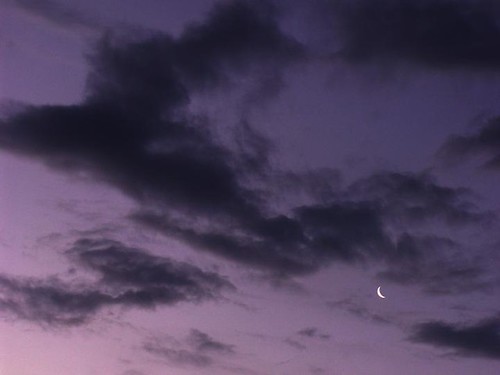
A night of very little sleep gave me a reward for my insomnia. The moon shown here, from the morning of February 24, is three days short of New. Clouds cover Venus to the left.
Coming up for air in the middle of a large job....
No packages today. I'm caught up on transcribing for now, but that's likely to change on Monday. I'm enjoying the free time while it's here, especially since I caught up on sleep last night. Now a hefty breeze ruffles the leaves outside and bird song accompanies the Metropolitan Opera broadcast of Camille Saint-Saens' Samson and Delilah.
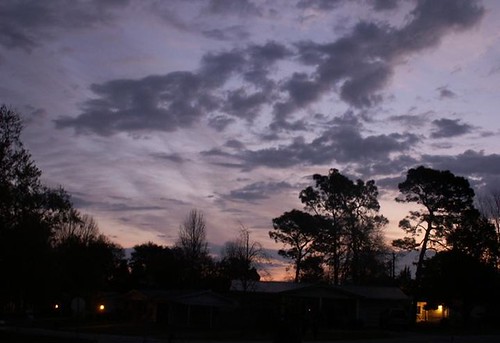
I'd opened up the blinds around 6 on Friday morning, then ran for camera and tripod. This was the scene at around 6:30. A stereoscopic view taken about 20 minutes later shows a bit of the cloud layers in 3D. By this time we were well-advanced into a fiery dawn.

We've been watching some domestic arachnid drama in our not-yet-working kitchen sink. (The sink is on our "to do" list but we've been working around it since the summer of 2004. Other home projects create enough disarray to keep plumbing on the back burner.) In the absence of pesky humans and their dishes, an American house spider (Achaearanea tepidariorum, Family Theridiidae) has taken up residence.

Here she's bagged a silverfish and earns her keep as "natural insecticide." Usually she rests out of sight inside a cloth draped around our nonworking faucet. Her species ranges throughout the US and Canada.
Our girl now seems to have a couple of suitors at her doorstep. At least, they look like potential mates, which might also make them potential food. We've been peeking into the sink now and then to check in on the trio.
These folks are cousins to black widows, who also belong to Theridiidae. This is not remarkable -- Theridiidae, also called Comb-Footed Spiders, form one of the largest spider families, with more than 200 species in North America. Comb-footed spiders spin irregular webs made of sticky strands (what we commonly call cobwebs) and use comblike bristles to fling those strands over their captives. The spider injects its prey with venom and stores it at a rest site on the web for later meals.
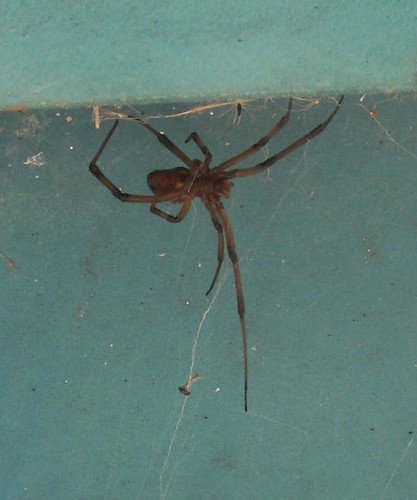
Outside an immature male black widow (Latrodectus mactans) has been hanging beneath the lip of our water storage bin. An older widow, likely an adult male by its shape and proportions, lived inside the container last year. Black widows range from Massachusetts to Florida, west to California, Texas, Oklahoma, and Kansas, and are most common in the South.
This one doesn't bite. The male black widow's abdomen is more elongated than the female's and its legs are longer in relation to its body. (For comparison, my shot of a female guarding egg sacs is here.) This male's abdomen has faint touches of red, though neither males nor immatures achieve the full hourglass shape seen in the adult female.
The brown coloration shows this one is immature. Black widow spiderlings are orange, brown, and white, gaining more black at each molt. Once this male is old enough to mate, he will likely be eaten by his partner afterwards. She will store his sperm, producing more egg sacs without the need to mate again. Potentially she can live longer than three years.
(Source: the Audubon Society Field Guide to North American Insects and Spiders.)
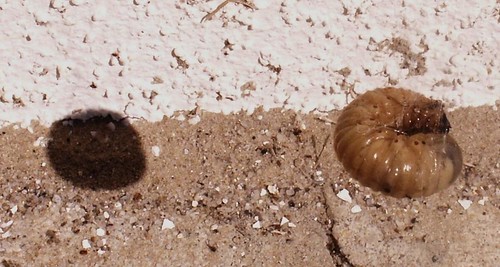
Mary had spotted this grub, likely dead or dying, hanging in midair inside spiderweb filaments. The round dark spot at left is its shadow thrown on the ground.
It's hard to tell at this stage what species of caterpillar this would have become, but already it shows signs of future markings. Evenly-spaced round spots dot the sides. I think the less-well-defined shape just behind the end closer to the camera marks the beginning of a large, fake "eye spot." What might have been.
I finally tried one of the Backpacker's Pantry meals Mary ordered from Campmor. This first order was to see what meals we prefer over others for hiking, and this past hurricane season it served as backup food in case of storm-related disruptions in, oh, everything. (We were lucky in 2005, limited only to some low tropical-force breezes and impressive clouds. In 2004 we experienced 6 days without power, 4 from Frances and 2 from Jeanne. All told, we were lucky in 2004, too.)
These are nifty products -- pricey for my hiking needs (I tend to rely on canned chicken and bagged gorp) but perfect for hunkering down during a storm, because at those times comfort food really makes a difference. Theoretically one adds boiling water to packets designed to stand upright so that cooking occurs inside the packet, but water straight from the tap works just as well for us. (Cooking instructions are designed for a 5,000-foot elevation, with cooking time doubling for each additional 5,000 feet. Not something we need to worry about in Florida.) The Spicy Thai Peanut Sauce I had today ("a savory sauce over rice and Asian vegetables") was very good.
I have a story set to mail out on Monday, and am still learning how much the industry has changed in my absence. Simultaneous submissions are much more common and accepted than they used to be. This story has been held at an anthology since June of 2004 -- a stasis paralleling that of our kitchen sink, come to think of it -- and a call to the editor revealed that, yes, they are still considering it; they're just rather overwhelmed at this point. Likely they'll expand from one anthology to two.
But the person I spoke with had automatically assumed I was submitting elsewhere! I laughed and told her, "That's good to know," when she said she had no problem with simultaneous submissions.
In a way, this part of me needs to "grow up." I was an adolescent when I started submitting stories. I treasured my first rejection slip (from Galaxy magazine, now defunct) because to me it meant I had become a "real writer." I mailed my manuscripts via Fourth Class (now Media) mail because that was all I could afford out of my allowance, and I got used to waiting through long review periods -- not just for magazines but for the Postal Service. (A mail carrier in Brooklyn who delivered one rejected manuscript turned out to belong to a science fiction fandom group that I subsequently joined.) I never treated the industry as an industry and in many respects I still don't, but that is what it is.
And whatever anyone else might say, to me it is still Magic.
My business sense is more finely honed for the work I do that supports the writing. I know I need to take some of those sensibilities and apply them to my more creative endeavors.
As in long writing jags, my long transcription jags keep me indoors in various states of quasi-dress. During breaks I've added to my photo documentation of household objects.
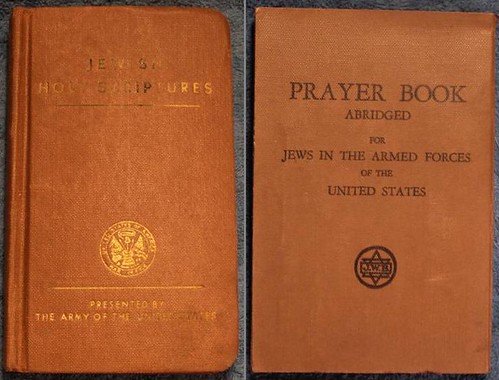
By the time I was born my father had become an atheist, and remained so for the rest of his life. After he died I found relics of his earlier life in the bottom drawer of his dresser. (Other items stored there included a tallit (prayer shawl) and tefillin (phylacteries).) These books likely traveled with him through Europe during World War II.
The Jewish Holy Scriptures, Presented by the Army of the United States on the left is hardcover, contains only English text, and was printed by the U.S. Government Printing Office in 1942. It also bears a 1917 copyright by the Jewish Publication Society of America, so was likely also used by Jews fighting in World War I. It contains excerpts from the Tanakh (known more commonly as the "Old Testament"). Photographed in slightly smaller scale, it measures 5-1/4 x 3-1/4 inches.
The Prayer Book Abridged for Jews in the Armed Forces of the United States on the right is paperback, with its spine on the right rather than the left and with its pages numbered from right to left. It contains specific prayers rather than Biblical passages (although it does contain some of the Psalms). These include prayers for the Sabbath and High Holy Days, the Mourner's Kaddish, and others that include a memorial prayer for those fallen in battle, prayer on being delivered from danger, prayers for the sick and wounded, prayer during a sea voyage, prayer for the U.S., prayer for moral strength, prayer for home, etc. Right-hand pages are in Hebrew, left-hand pages in English. This book was published not by the U.S. government but by the National Jewish Welfare Board (printed by the Jewish Publication Society), copyright 1941 and 1943. Its original edition of 250,000 copies had been printed in 1917. The two editions printed during World War II number 400,000 and 800,000 copies, respectively. It measures 5 x 3-1/4 inches.
I was fascinated to find these, since I grew up largely non-observant. My own spirituality is not tied to any one religion, though Judaism (and my interpretation of it) is where my roots lie. Many items in the Brooklyn house of my childhood moved here in 1980, including those of which I was never aware. It's been an ongoing voyage of discovery.











2 Comments:
You surely have the busiest kitchen sink! Amazing shots, too. It sounds like a meandering weekend of quiet enjoyment, from sunsets to spiders to your dear Father's library... I enjoyed browsing with you!
beautiful photo! I found you via Yankee Transplant, am enjoying the visit!
Post a Comment
<< Home